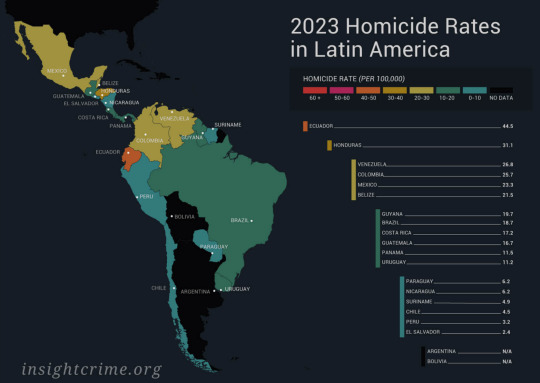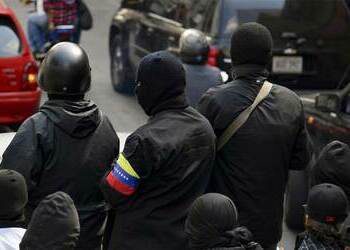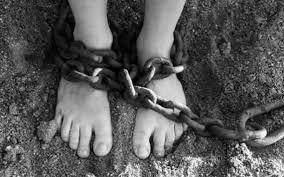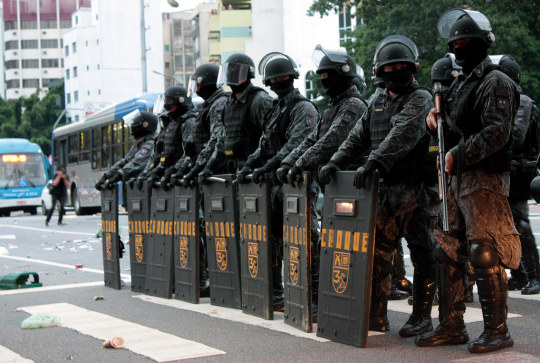#InSightCrime
Photo

2023 Homicide Rates in Latin America
115 notes
·
View notes
Photo

Illegal Jaguar Poaching Suriname - Insightcrime
0 notes
Text
GÉNOCIDE : Plus de 570 enfants Yanomami de moins de cinq ans sont morts au cours des quatre dernières années de maladies évitables directement liées …
InsightCrime “Plus qu’une crise humanitaire, ce que j’ai vu à Roraima était un génocide. Un crime prémédité contre les Yanomami, commis par un …GÉNOCIDE : Plus de 570 enfants Yanomami de moins de cinq ans sont morts au cours des quatre dernières années de maladies évitables directement liées …

View On WordPress
0 notes
Link
La frontière Brésil/Venezuela est dominée par l'extraction illégale d'or depuis des décennies et une partie substantielle de l'or du sang Yanomami transite par le Venezuela et s'infiltre dans la chaîne mondiale d'approvisionnement en or, déclarée avec de faux documents comme de l'or « d'origine légale ».
«La malnutrition sévère qui touche des familles entières dans divers groupes Indigènes à travers le Brésil doit être traitée de toute urgence, car notre humanité en dépend !»
0 notes
Text
Grupos del Crime organizado se adapta al coronavirus en Argentina
Grupos del Crime organizado se adapta al coronavirus en Argentina
Las medidas impuestas por el Gobierno Argentino para frenar la propagación del coronavirus, como el cierre de las fronteras y el confinamiento obligatorio, han afectado el crimen organizado que opera en la región. Sin embargo, hay indicaciones que los grupos criminales transnacionales se están adaptando.
Entre finales de abril y la primera semana de mayo, la Prefectura Naval y la Gendarmería…
View On WordPress
0 notes
Text
Between 2000 and 2015, Costa Rica's Murder Rate Nearly Doubled
Between 2000 and 2015, Costa Rica’s Murder Rate Nearly Doubled
GAMECHANGERS: A roundup of the most important criminal developments in the Americas during 2016 and what to expect in 2017
(Q24N) InSightCrime.org, a non-profit journalism and investigative organization specialized in organized crime in Latin America and the Caribbean, with offices in Washington, D.C. and Medellín, Colombia has produced a roundup report of the most important criminal developments…
View On WordPress
0 notes
Text
Between 2000 and 2015, Costa Rica's Murder Rate Nearly Doubled
Between 2000 and 2015, Costa Rica’s Murder Rate Nearly Doubled
GAMECHANGERS: A roundup of the most important criminal developments in the Americas during 2016 and what to expect in 2017
(Q24N) InSightCrime.org, a non-profit journalism and investigative organization specialized in organized crime in Latin America and the Caribbean, with offices in Washington, D.C. and Medellín, Colombia has produced a roundup report of the most important criminal developments…
View On WordPress
0 notes
Note
Are drug cartels of Mexico more powerful then the federal Mexican government?
I’ll recommend you to InsightCrime. A friend of mine, Chris Dalby, writes for them and they discuss organized crime in Latin America.
-SLAL
11 notes
·
View notes
Text
"Klansman trial reveals Jamaica's sophisticated gang dynamics"
“Klansman trial reveals Jamaica’s sophisticated gang dynamics”
https://twitter.com/InSightCrime/status/1461356185613856779?s=20
View On WordPress
0 notes
Photo

The number of Latin American countries which support the US war on drugs has plummeted. Paraguay and the Dominican Republic are among the very few whose loyalty has not wavered.
by @InSightCrime
178 notes
·
View notes
Text
Colectivos Ramp Up Property Seizures in Venezuela
Colectivos Ramp Up Property Seizures in Venezuela
Photo by InSightCrime
An increase in the number of reports of illegal invasions of homes and commercial establishments in Venezuela during the pandemic has revealed the ever-widening criminal portfolio managed by militant civilian groups known as “colectivos.”
By VENEZUELA INVESTIGATION UNIT / InSightCrime
In early January, residents of El Recreo, a neighborhood in the Libertador municipality…

View On WordPress
0 notes
Text
Trata de personas en México

¿Que es?

Es entre muchas cosas, el ofrecimiento de personas por medio de la violencia física o moral; el engaño o abuso de poder para someterla a explotación sexual, trabajos o servicios forzados, esclavitud o la extracción de un órgano, tejido o sus componentes.
Este fenómeno es sumamente importante porque afecta los derechos humanos, y se remonta a cientos de años en el pasado.
La trata de personas como problema social se reconoció a finales del siglo XIX e inicios del siglo XX, denominado “trata de blancas” esto como referencia al comercio de mujeres blancas, europeas o americanas , para explotarlas sexualmente.
Algunas de las principales disciplinas que pueden estudiar dicho fenómeno son:
-Ciencias Jurídicas
- Ciencia Política
-Comunicación
-Demografía
-Ecología
-Psicología Social
-Relaciones Internacionales
-Sociología
Las principales clases sociales involucradas en este problema son aquellas que presentan características de vulnerabilidad como la clase baja, cuyos integrantes presentan pobreza extrema, esta clase social es por lo general las víctimas, debido a sus posición económica; la otra clase social involucrada es la consumidora que sería la clase alta debido a su posibilidad económica. Esto no quiere decir que la trata de personas se excluye a estas clases sociales, pero sí que son las mayormente involucradas.

Instituciones que intervienen en dicho proceso:
-Secretaria de gobernacion
-Instituto Nacional de Migración.
-Secretaria de Relaciones Internacionales
-Procuraduría General de la República
-Instituto Nacional de las Mujeres
Alternativas viables para la atención del problema:
-Generar conciencia entre la ciudadanía
- Empoderar sectores estratégicos
-Apoyar la labor policial tradicional
-Rastrear las finanzas

M. (2020, 16 octubre). La trata de personas, una ruta del dolor. CNN. https://cnnespanol.cnn.com/2020/10/16/la-trata-de-personas-una-ruta-del-dolor/
SEGOB. (s. f.). SEGOB. gobernacion.gob.mx. Recuperado 31 de octubre de 2020, de http://www.gobernacion.gob.mx/work/models/SEGOB/comision/pdf/INSTITUCIONES%20PUBLICAS%20Y%20ORGANIZACION%20DE%20LA%20SOCIEDAD%20CIVIL%20QUE%20BRINDAN%20ATENCION%20A%20PERSONAS%20VICTIMAS%20DE%20TRATA.pdf
Garcia, J. (2017, 29 mayo). Sujetos vulnerables en la rata de seres humanos. Los casos en México y España. unilim.fr. https://www.unilim.fr/trahs/74
Garcia, D. (2019, 10 septiembre). 5 estrategias para combatir la trata de personas en América. insightcrime. https://es.insightcrime.org/noticias/analisis/5-estrategias-combatir-trata-personas-america/
0 notes
Text
13 Reasons Why You Should Boycott Gold For The Yanomami People — Palm Oil Detectives
Image: InSightCrime Hunger for Gold in the Global North is fueling a living hell in the Global South. Here are 20 reasons why you should #…13 Reasons Why You Should Boycott Gold For The Yanomami People — Palm Oil Detectives

View On WordPress
0 notes
Text
Historic homicide reduction in El Salvador continues to spur debate in the country
New Post has been published on http://khalilhumam.com/historic-homicide-reduction-in-el-salvador-continues-to-spur-debate-in-the-country/
Historic homicide reduction in El Salvador continues to spur debate in the country
Journalists believe the government held secret negotiations with gangs
Screenshot from Al Jazeera news report from September 6, 2020, on YouTube.
After 15 months of governance, it seems that president Nayib Bukele — a 37-year-old politician who put an end to an old two-party system — is delivering on his promise to reduce El Salvador’s legacy of violence and homicides. Since he took office, El Salvador has had the lowest homicide rate since 2015, the deadliest year El Salvador suffered recently. Yet, hypotheses and analyses of how the statistics have dropped are subject to much debate in the country. President Nayib Bukele attributes the success to his “territorial control plan“. On the other hand, some analysts, journalists, and the political opposition believe that Bukele has a secret truce with gangs to lower homicides and win votes in the next parliamentarian elections in February 2021, as reported in the El Faro newspaper. Bukele's territorial control plan consists of seven phases that will be implemented during his term in office. The first three phases are about increasing the presence of security forces on the streets, modernizing the equipment of police forces, and prevention activities for youth at risk. The estimated cost of the security plan's initial three phases is $575 million. As of today, only phase one and part of phase two have been implemented. Lack of funding is delaying the implementation of phase three. Phase one of the security plan aims at “taking back control” of the territory controlled by gangs. To accomplish this, the government deployed a large number of soldiers to help the National Police with security and moved high ranking gang members into separate prisons, mixed rival gangs in the same jail cells, and removed all phone devices from the jails.
Autoridades de @CentrosPenales trasladaron a varios reos de alta peligrosidad a cárceles con mayor rigurosidad, con el objetivo que no sigan ordenando delitos. Esta acción es parte del #PlanControlTerritorial implementado por el gobierno, informa @SeguridadSV_. Fotos cortesía. pic.twitter.com/a2yDzCfpaj — elsalvador.com (@elsalvadorcom) June 21, 2019
Authorities from @CentrosPenales moved several highly dangerous inmates to prisons with greater control, with the aim of stopping them from ordering crimes. This action is part of the #PlanControlTerritorial implemented by the government, reports @SeguridadSV_.
Sofía Martinez, an expert consultant in Central American security, questioned the tactics used by President Bukele, which were already implemented by previous presidents from 2003 to 2018. None of which had given positive results in the past. The investigative digital newspaper El Faro reported on September 3 that Bukele's government had secretly negotiated with the largest gang in El Salvador, MS-13, to reduce the number of homicides and receive electoral support. MS-13 is perhaps the most notorious and arguably most violent street gang in the Americas. This gang is firmly established in all 14 departments of El Salvador, both in urban and rural areas. El Faro asserted that they had hundreds of pages, such as reports and logbooks from maximum-security prisons, as evidence. El Faro wrote:
The documents reveal negotiations between the Salvadoran administration and incarcerated leaders of MS-13 dating back to June of 2019, when President Bukele took office.
El Faro stated that in return for lowering the homicides and getting electoral support in the upcoming elections, MS-13 would receive small prison privileges such as receiving fried chicken, pizza, candy, and pupusas in their gang cell blocks and the removal of aggressive prison guards. Larger benefits would also be at play, such as revoking the decision to mix rival gangs in the same jail cell and “even promising to soften the maximum-security regime, repeal laws, and give gang members ‘benefits’ if the government can take control of the Legislative Assembly in the elections in February 2021,” according to El Faro. The Bukele administration swiftly responded to El Faro's allegations by ridiculing its claims on Twitter. Vice Minister of Justice and General Director of Penal Centers Osiris Luna took reporters to all three prisons mentioned in El Faro's report to show that inmates had no benefits of any kind and that rival gangs were housed in the same jail cell. The report by El Faro is not the first of its kind that came out indicating the alleged gang truce between the government and gangs. The International Crisis Group wrote an article on July 8 that questioned whether the plunging violence was “a miracle or mirage”. Furthermore, on October 1, InSightCrime published an investigation on Bukele and gangs that dates back to the time he was mayor of San Salvador. The investigation by InSightCrime focuses on the rehabilitation of the San Salvador Historic District. InSightCrime stipulates that the rehabilitation of the historic district was accomplished by Bukele due to secret negotiations with gangs in the area. President Bukele has continued to criticize and ridicule El Faro and other media outlets for the reports on his administration. This criticism of El Faro and other media outlets has raised worries among journalists and international observers about freedom of the press in El Salvador. Latin American journalists asked IACHR to act on the president's attacks in El Salvador in the context of the slandering of El Faro. President Nayib Bukele denied accusations that he is attacking the press:
“Algunos periodistas dicen que este gobierno ataca a la prensa; nosotros estamos comprometidos con la libertad de expresión, pero algunos pasan publicando una sarta de mentiras y lo que nosotros hacemos es desmentirlos. Eso no es violar la libertad.” Presidente Nayib Bukele.
“Some journalists say that this government attacks the press; we are committed to freedom of expression, but some go around publishing a string of lies and what we do is deny them. That is not violating freedom.” President Nayib Bukele.
In 2012, a secret truce to lower the homicide rate was adopted by the ex-president Mauricio Funes administration and both main Salvadoran gangs, MS-13, and 18th Street. The killings dropped in 2012 and 2013, but when the truce fell out, the number of homicides spiked to the infamous 2015 rate of 18.2 daily murders. Journalist Oscar Martinez fears that this might happen again if there is a secret truce today between the government and the gangs. He encourages the president to openly negotiate with the gangs to restore peace in society. However, Martinez may be in the minority as the vast majority of the population is opposed to negotiations with gangs either in secret or in public according to polls dating from 2014. Those surveyed stated that negotiations give legitimacy to ruthless criminal organizations.
Soon after the El Faro allegations were made public, the Salvadoran General attorney Raul Melara opened an investigation into the alleged secret negotiations.
Written by Eddie Galdamez
0 notes
Text
So Different Yet So Alike: The Militarization of Police in Brazil and Haiti
Kira Paulemon, Intern for Colombia Program

Flickr
In our Latin American History classes, we often read about civil wars and revolutions, about mass murders and state-sponsored acts of intimidation. Police officers all over the region shared duties with members of armies, and acted as such. This translated into highly politicized institutions and the development of a cultural trend to have public forces (i.e.: police officers) employ extreme use of force. The controversy behind this statement is that essentially, these two bodies were made for completely different reasons; militaries are intended for warfare, they defeat enemies with maximum force while police are supposed to protect and serve populations with minimum force.
To think that these practices were put to rest as the “Third Wave” of democracy hit Latin America during the 1980s would be to undermine the legacy of previous armed regimes on current police forces. In countries like Haiti and Brazil, we’ve seen situations where members of the police are not just complicit but often leaders in acts of violence. One could talk about police brutality in the United States, and as much as that conversation is warranted, it belongs in a broader discussion of police forces around Latin America and their interactions with civil society.
The two countries cited are particularly compelling to look at because they involve a variety of demographics, resources, and political culture, yet both carry the remnants of military dictatorships from the 1980’s and 1990’s and seem to be experiencing the same shift within their police forces, even if for different reasons.
On November 1st and November 13, 64 people were killed in La Saline, one of Haiti’s poorest, most vulnerable, and violent neighborhoods. According to reports by the National Network for the Defense of Human Rights (RNDDH), the UN Mission for Justice Support in Haiti (MINUJUSTH) and countless other observatory organizations, this was the result of gang violence. Interestingly enough, the presence of government officials and police officers was recorded. In 2006, the neighborhood of Martissant saw armed men and police officers interrupting a friendly soccer game, killing many who were attending.
These events could be linked closely to corruption, which is rampant within Haitian institutions. However, an alternative explanation that has not yet been exploited is that in the process of dismantling authoritarian regimes’ internal structures were not revamped to create bodies meant to address the population’s security needs in a demilitarized way. As noted in an earlier WOLA report, before the Haitian National Police (HPN) was up and running, an interim body was effectively staffed by former members of the Army, meaning that military cultures and practices were passed along and survived to become relevant in the discourse around recent security practices, not just in Haiti but in other countries, too, like Brazil.
In South America’s largest country, legislators will vote in the near future on a set of laws meant to facilitate killings by police officers. This tendency of systematic state participation in violent spaces and actions has become the norm.
Just as in Haiti, Brazil has seen its police merge its responsibilities with that of the Army, which is supposed to be a fundamentally different institution. Human Rights Watch notes that several laws were adopted transferring army-like capabilities to police. First, a law enacted in 2017 mandated that trials involving military police officers who are accused of human rights violations crimes, such as torture, be taken to military courts rather than civil courts, compromising judicial independence and increasing the likelihood of impunity This was followed by then-President Michel Temer’s decision to redirect the responsibility of public security in prisons from civil to military police. These decisions, followed by the election of Jair Bolsonaro and his “tough on crime” agenda, have given leeway to an already out-of-control state police. Brazilian public forces account for some of the most violent in Latin America, they also tend to target poor and predominantly black Brazilians. A crooked institution paired with a racist approach amount to the systematic killing of the most vulnerable populations within and outside of Brazil’s biggest cities. In the first 3 months of 2019, Brazilian police had already killed 434 people in Rio de Janeiro (out of which 160 happened in January, according to InsightCrime). These numbers are even more shocking when you put down that 77% of police killings are of black people.
Finally, Brazilian peacekeeping troops also influenced the HPN’s way of dealing with the Haitian population. Between 2004 and 2006, under the direction of Brazilian General Augusto Heleno Periera, the National Police developed a very violent system for raids (the same they used in LaSaline and other cases).
If the analysis of police forces in these very two different countries shows us anything, let it be a reminder that cultures and traditions are passed along through institutions, surviving transitions from dictatorship to democracy. Countries around the hemisphere must work inwardly to not only separate their military and civilian forces, but to create mechanisms of accountability to limit the state’s involvement in violent acts. Many might say that militarized police forces have become a trend in Latin America, but the reality of it is that militarized practices were never completely erased in many Latin American and Caribbean nations. They have adapted themselves and hidden under the banner of police.
For these reasons we are still seeing 53 people killed in one night in Haiti, Afro-Brazilians openly targeted in their own neighborhoods, and protesters being violently repressed in Honduras. The skeletons of autocracy are standing and are battling neck to neck with our democratic establishments. A closer look is needed to understand and reform Latin American police forces, as they need to become supports for their communities and not sources of repression.
0 notes
Text
A tweet
"Mexican organized-crime groups have branched out into octopus theft — via InsightCrime … http://pic.twitter.com/gKONf8qKEG"https://t.co/YMMph0WVII
— MarketingForJustice (@market4justice) October 30, 2017
0 notes